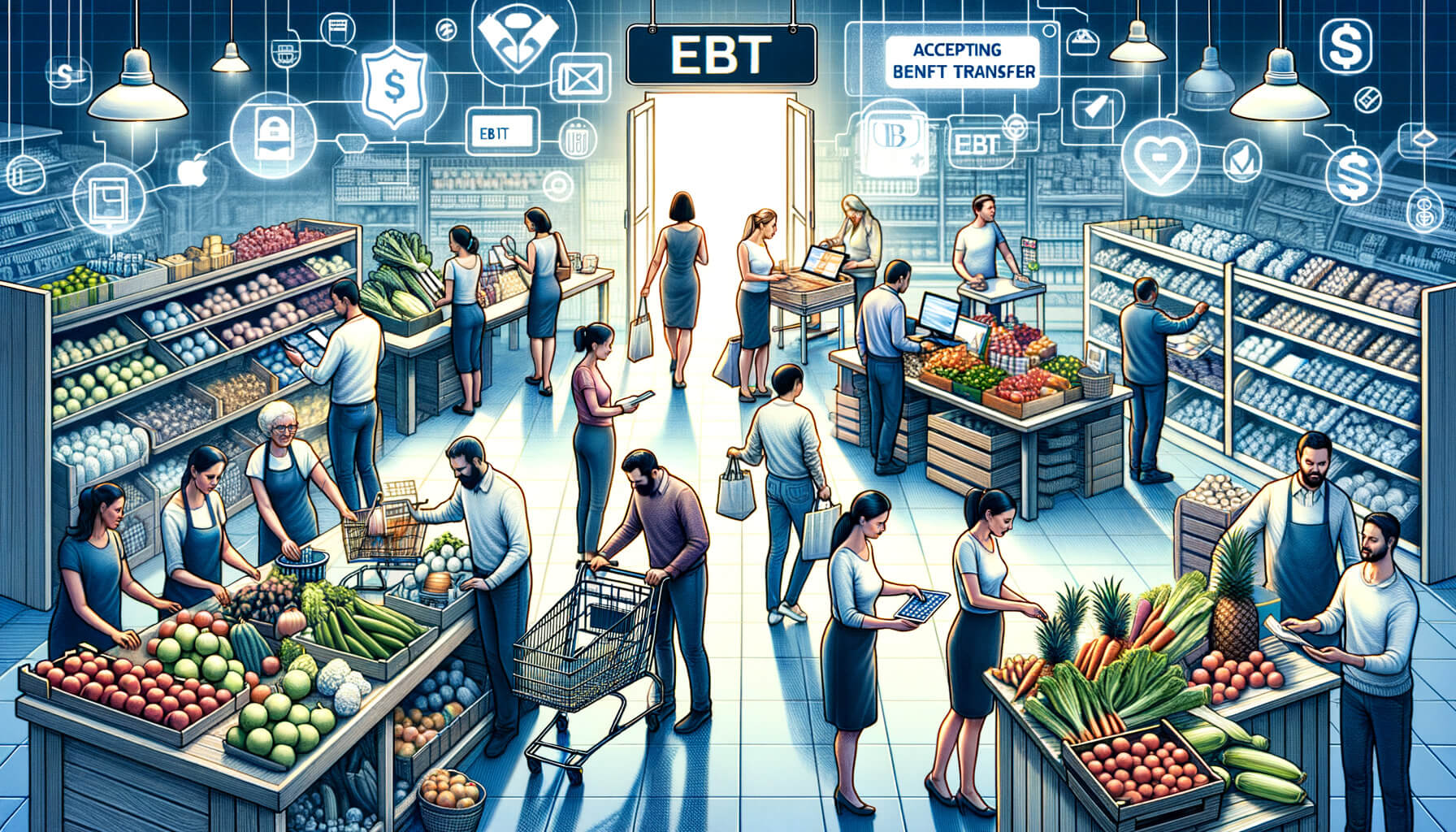
By Ethan Brooks November 2, 2024
The Electronic Benefits Transfer (EBT) system is a crucial tool in supporting low-income communities by providing them with access to essential resources. EBT is a government-issued card that allows recipients to purchase food and other necessities using funds from programs like the Supplemental Nutrition Assistance Program (SNAP). This system not only facilitates the distribution of benefits but also empowers individuals and families by ensuring they have the means to meet their basic needs.
To begin with, EBT plays a significant role in reducing food insecurity among low-income households. By providing a reliable source of funds specifically for purchasing food, EBT helps ensure that families do not have to choose between paying for groceries and other essential expenses. This is particularly important in communities where access to affordable, nutritious food is limited. With EBT, recipients can shop at participating retailers, including grocery stores and farmers’ markets, thereby supporting local economies and promoting healthier eating habits.
Moreover, the EBT system is designed to be user-friendly and efficient, which is vital for empowering low-income individuals. The card functions much like a debit card, allowing users to make purchases with ease and dignity. This reduces the stigma often associated with receiving government assistance, as transactions are discreet and straightforward. Additionally, the EBT system is continually being updated to incorporate new technologies, such as mobile apps, which further enhance accessibility and convenience for users.
Another critical aspect of EBT is its role in supporting vulnerable populations, including children, the elderly, and individuals with disabilities. These groups are often disproportionately affected by poverty and food insecurity, making access to EBT benefits even more essential. By ensuring that these individuals have the resources they need to maintain a healthy diet, EBT contributes to improved health outcomes and overall well-being. This, in turn, can lead to better educational and employment opportunities, breaking the cycle of poverty for future generations.
Furthermore, EBT empowers low-income communities by fostering a sense of independence and self-sufficiency. By providing individuals with the means to purchase their own food, EBT allows them to make choices that best suit their needs and preferences. This autonomy is crucial for building confidence and promoting a sense of agency among recipients. Additionally, EBT benefits can be used to purchase seeds and plants for growing food, encouraging self-reliance and sustainable practices within communities.
In addition to its direct benefits for recipients, the EBT system also has broader economic implications. By increasing the purchasing power of low-income individuals, EBT stimulates demand for goods and services, thereby supporting local businesses and creating jobs. This economic activity can lead to increased tax revenues, which can be reinvested in community development initiatives. Moreover, by reducing food insecurity and improving health outcomes, EBT can help lower healthcare costs and reduce the burden on social services, resulting in long-term savings for society as a whole.
What is EBT and How Does it Work?
EBT, or Electronic Benefit Transfer, is a system that allows recipients of government assistance programs, such as the Supplemental Nutrition Assistance Program (SNAP), to access their benefits electronically. Instead of receiving paper food stamps, recipients are issued a plastic card, similar to a debit or credit card, which they can use to purchase eligible food items at authorized retailers. The benefits are loaded onto the card each month, and recipients can use it to make purchases at participating stores.
The Economic Impact of Accepting EBT for Businesses

The economic impact of accepting Electronic Benefit Transfer (EBT) for businesses is a multifaceted topic that encompasses various aspects of financial growth, community engagement, and market expansion. As businesses consider the integration of EBT systems, it is crucial to understand how this decision can influence their economic landscape.
Accepting EBT can significantly broaden a business’s customer base by including low-income individuals who rely on government assistance programs such as the Supplemental Nutrition Assistance Program (SNAP). This expansion is not merely about increasing foot traffic; it is about tapping into a demographic that represents a substantial portion of the consumer market. By accepting EBT, businesses can attract customers who might otherwise be unable to afford their products, thereby increasing sales volume and revenue.
Moreover, the decision to accept EBT can enhance a business’s reputation within the community. It demonstrates a commitment to inclusivity and social responsibility, which can foster customer loyalty and positive word-of-mouth. In today’s socially conscious market, consumers are increasingly drawn to businesses that prioritize ethical practices and community support. Therefore, by accepting EBT, businesses not only contribute to the welfare of low-income individuals but also position themselves as community-oriented enterprises.
In addition to these benefits, accepting EBT can provide businesses with a competitive edge. In areas with a high concentration of EBT users, businesses that do not accept EBT may lose potential customers to competitors who do. This competitive advantage is particularly relevant for grocery stores, farmers’ markets, and other food retailers, where EBT usage is most prevalent. By accommodating EBT users, businesses can capture a larger share of the market and potentially increase their profitability.
Furthermore, the implementation of EBT systems can lead to operational efficiencies. Modern EBT systems are designed to be user-friendly and integrate seamlessly with existing point-of-sale systems. This integration can streamline the checkout process, reduce transaction times, and minimize errors associated with manual payment methods. As a result, businesses can improve their overall operational efficiency, which can translate into cost savings and enhanced customer satisfaction.
However, it is important to acknowledge the initial costs and logistical considerations associated with accepting EBT. Businesses must invest in the necessary technology and training to ensure a smooth transition. Despite these initial challenges, the long-term economic benefits often outweigh the costs. Government incentives and support programs are also available to assist businesses in implementing EBT systems, making the transition more feasible for small and medium-sized enterprises.
The Benefits of Accepting EBT for Businesses

Accepting EBT can bring numerous benefits to businesses, especially those located in low-income communities. By becoming an authorized EBT retailer, businesses can tap into a significant customer base that relies on government assistance to meet their basic needs. This can lead to increased foot traffic, higher sales, and improved customer loyalty.
- Expanding Customer Base: Accepting EBT allows businesses to cater to a wider range of customers, including low-income individuals and families who heavily rely on government assistance. By accommodating their needs, businesses can attract a loyal customer base and build a positive reputation within the community.
- Increased Sales: Low-income individuals often have limited financial resources, and accepting EBT can provide them with the opportunity to purchase essential food items. By accepting EBT, businesses can tap into this market and increase their sales volume. This can be particularly beneficial for grocery stores, farmers markets, and other food-related businesses.
- Enhanced Customer Loyalty: When businesses accept EBT, they demonstrate their commitment to serving the needs of the community. This can foster a sense of loyalty among low-income customers, who may choose to support businesses that prioritize their well-being. By building trust and loyalty, businesses can establish long-term relationships with their customers.
- Competitive Advantage: In areas with a high concentration of low-income individuals, accepting EBT can provide a competitive advantage. By catering to the needs of this underserved population, businesses can differentiate themselves from competitors and position themselves as socially responsible entities.
Improving Access to Nutritious Food for Low-Income Individuals

One of the primary reasons for accepting EBT is to improve access to nutritious food for low-income individuals. Food insecurity is a significant issue in many communities, with millions of Americans struggling to afford enough food for themselves and their families. By accepting EBT, businesses can contribute to addressing this problem and ensure that low-income individuals have access to the food they need to lead healthy lives.
- Availability of Nutritious Food: Accepting EBT encourages businesses to stock a wide variety of nutritious food options. This is particularly important in low-income communities where access to fresh fruits, vegetables, and other healthy foods may be limited. By offering a diverse range of nutritious options, businesses can help improve the overall health and well-being of low-income individuals.
- Encouraging Healthy Eating Habits: By accepting EBT, businesses can play a role in promoting healthy eating habits among low-income individuals. Many low-income individuals face barriers to accessing nutritious food, such as limited transportation options or high prices. By accepting EBT, businesses can help overcome these barriers and encourage individuals to make healthier food choices.
- Supporting Local Farmers and Producers: Accepting EBT can also benefit local farmers and producers. Farmers markets and other direct-to-consumer outlets often accept EBT, allowing low-income individuals to purchase fresh, locally grown produce. This not only supports local agriculture but also provides low-income individuals with access to high-quality, nutritious food.
Reducing Stigma and Promoting Inclusivity
Accepting EBT can help reduce the stigma associated with government assistance programs and promote inclusivity within communities. Many low-income individuals face judgment and discrimination due to their reliance on government assistance. By accepting EBT, businesses can create an inclusive environment where all customers are treated with dignity and respect.
- Dismantling Stigma: Accepting EBT sends a powerful message that businesses are committed to serving all members of the community, regardless of their socioeconomic status. This can help dismantle the stigma associated with government assistance programs and challenge negative stereotypes about low-income individuals.
- Fostering Inclusivity: By accepting EBT, businesses create an inclusive environment where low-income individuals feel welcome and valued. This can help build a sense of community and belonging, fostering social cohesion and reducing social isolation among low-income individuals.
- Empowering Low-Income Individuals: Accepting EBT empowers low-income individuals by providing them with the means to make their own purchasing decisions. It allows them to shop for food in the same way as other customers, without feeling singled out or stigmatized. This empowerment can have a positive impact on their self-esteem and overall well-being.
EBT and Economic Stimulus: Boosting Local Economies
Accepting EBT can have a positive impact on local economies by stimulating economic activity and supporting local businesses. When low-income individuals have access to government assistance programs like SNAP, they are more likely to spend their benefits on essential goods and services, including food. By accepting EBT, businesses can benefit from this increased spending and contribute to the economic growth of their communities.
- Increased Consumer Spending: Accepting EBT can lead to increased consumer spending, as low-income individuals have more purchasing power. This can have a multiplier effect on the local economy, as increased spending creates demand for goods and services, which, in turn, supports job creation and economic growth.
- Supporting Local Businesses: When low-income individuals spend their EBT benefits at local businesses, it helps support the local economy. This is particularly important in low-income communities, where businesses may struggle to attract customers and generate revenue. By accepting EBT, businesses can tap into this potential market and contribute to the economic vitality of their communities.
- Job Creation: Increased consumer spending resulting from accepting EBT can lead to job creation. As businesses experience higher sales volumes, they may need to hire additional staff to meet the increased demand. This can provide employment opportunities for individuals in the community, including those who may be struggling to find stable employment.
Addressing Food Insecurity and Hunger
Food insecurity and hunger are pressing issues that affect millions of individuals and families in the United States. Accepting EBT can play a crucial role in addressing these challenges and ensuring that low-income individuals have access to an adequate and nutritious food supply.
- Alleviating Food Deserts: Food deserts, areas where access to affordable and nutritious food is limited, are prevalent in many low-income communities. By accepting EBT, businesses can help alleviate food deserts by providing low-income individuals with access to a variety of food options. This can help ensure that individuals have the resources they need to maintain a healthy diet.
- Combating Hunger: Accepting EBT can help combat hunger by providing low-income individuals with the means to purchase food. Hunger has severe consequences for individuals’ physical and mental health, as well as their overall well-being. By accepting EBT, businesses can contribute to reducing hunger and improving the quality of life for low-income individuals.
- Supporting Children and Families: Accepting EBT is particularly important for supporting children and families who may be at a higher risk of food insecurity. Children from low-income families are more likely to experience food insecurity, which can have long-term impacts on their health and development. By accepting EBT, businesses can help ensure that children have access to the nutritious food they need to thrive.
Overcoming Challenges and Misconceptions about EBT

While accepting EBT offers numerous benefits, there are also challenges and misconceptions that businesses may face. It is essential to address these concerns to ensure a smooth transition to accepting EBT and maximize the positive impact on low-income customers and communities.
- Technological Integration: One of the challenges businesses may face when accepting EBT is integrating the necessary technology into their existing payment systems. This may require investing in new hardware or software to process EBT transactions. However, many payment processing companies offer EBT integration solutions, making it easier for businesses to accept EBT.
- Staff Training: Businesses may need to provide training to their staff on how to process EBT transactions and understand the rules and regulations associated with accepting EBT. This can help ensure that the process is seamless and that customers receive the assistance they need when using their EBT benefits.
- Misconceptions and Stereotypes: Accepting EBT may be met with misconceptions and stereotypes about low-income individuals and government assistance programs. It is crucial for businesses to address these misconceptions and promote a positive narrative around accepting EBT. This can be done through education and community outreach initiatives.
- Administrative Burden: Some businesses may be concerned about the administrative burden associated with accepting EBT, such as record-keeping and compliance with program regulations. However, the benefits of accepting EBT, such as increased sales and customer loyalty, often outweigh the administrative challenges.
Frequently Asked Questions (FAQs)
Q1. How can businesses become authorized to accept EBT?
To become authorized to accept EBT, businesses need to apply with the United States Department of Agriculture (USDA) Food and Nutrition Service (FNS). The application process involves completing the necessary forms, providing documentation, and meeting specific requirements set by the FNS.
Q2. What types of businesses can accept EBT?
Various types of businesses can accept EBT, including grocery stores, supermarkets, farmers markets, convenience stores, and even some online retailers. The FNS has specific guidelines and requirements for each type of business, so it is essential to review the eligibility criteria before applying.
Q3. Can businesses accept EBT for non-food items?
EBT benefits are primarily intended for the purchase of eligible food items. However, some businesses, such as farmers markets, may be authorized to accept EBT for non-food items, such as plants and seeds for growing food. It is important for businesses to understand the specific rules and regulations regarding eligible items.
Q4. How are EBT transactions processed?
EBT transactions are processed similarly to debit or credit card transactions. The customer swipes or inserts their EBT card into the payment terminal, enters their Personal Identification Number (PIN), and the transaction is authorized. The amount of the purchase is deducted from the customer’s EBT balance.
Q5. Can businesses set minimum purchase amounts for EBT transactions?
No, businesses cannot set minimum purchase amounts for EBT transactions. The FNS prohibits businesses from imposing any additional requirements or restrictions on EBT transactions beyond what is allowed for other forms of payment.
Conclusion
Accepting EBT is crucial for low-income customers as it improves access to nutritious food, reduces stigma, boosts local economies, and addresses food insecurity and hunger. By becoming authorized EBT retailers, businesses can expand their customer base, increase sales, and foster customer loyalty. Accepting EBT also promotes inclusivity and empowers low-income individuals by providing them with the means to make their own purchasing decisions.
While there may be challenges and misconceptions associated with accepting EBT, the benefits far outweigh the potential drawbacks. By embracing EBT, businesses can make a significant impact on the lives of low-income individuals and contribute to building healthier, more inclusive communities.